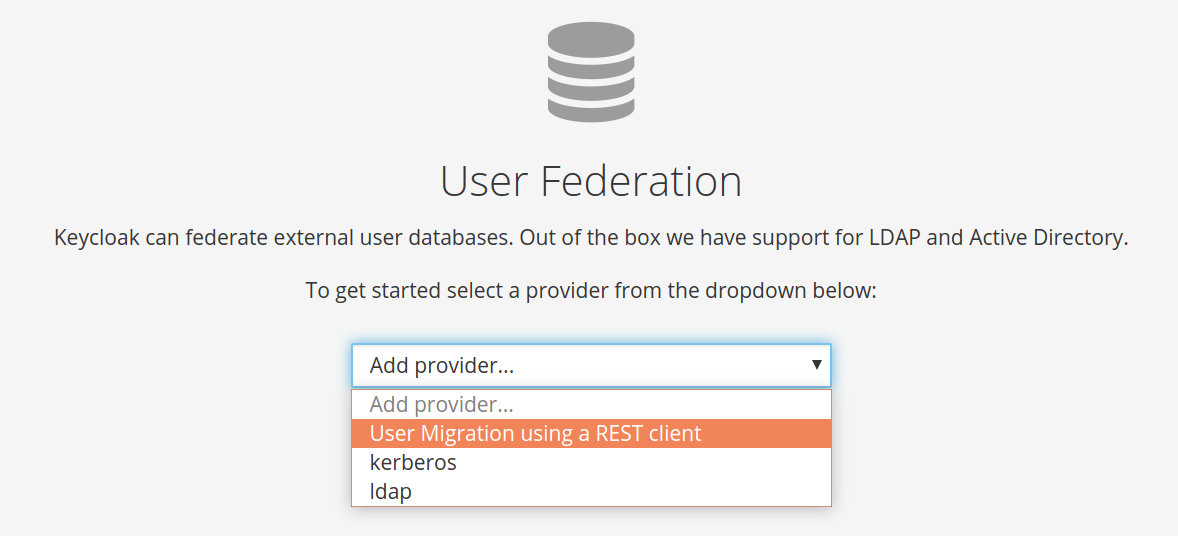This is a user migration plugin for Keycloak. Read more at:
https://codesoapbox.dev/keycloak-user-migration
| Keycloak Version | Commit |
|---|---|
| 15.X | Current |
| 12.X | 0966d9ba7c94ba461783a5d8dda0735a35c4e6b8 |
| 11.x | 9f59cdf7fa888c31c5cda3d1fe014c9a0682ab30 |
| 9.X | c9c64162b91cedc29d8bf360c3df50b69fdb4c6b |
You must provide two REST endpoints (GET and POST) in your legacy authentication system under the URI ${restClientUri }/{$username}, where ${restClientUri} is a configurable base URL for the endpoints and {$username} is the
username of the user that is attempting to sign in.
It is possible to configure the plugin to use the legacy userId instead of the username when making the
credential verification request. This option is useful if your legacy system allows users to change their
usernames and should only be used when the legacy user ids are migrated to Keycloak.
The GET request will have to return user data as a JSON response in the form:
{
"id": "string",
"username": "string",
"email": "string",
"firstName": "string",
"lastName": "string",
"enabled": "boolean",
"emailVerified": "boolean",
"attributes": {
"key": ["value"]
},
"roles": ["string"],
"groups": ["string"],
"requiredActions": ["requiredActions"]
}Any HTTP status other than 200 will be interpreted as the user not having been found.
The id attribute in the above response is optional. If it's not set Keycloak will generate a new user id automatically.
The POST request is for password validation. It will have to accept the following body:
{
"password": "string"
}...And return HTTP status 200 if the password is correct. Any other response will be treated as invalid credentials.
Let's assume we have configured the legacy REST service under the URL http://www.old-legacy-system.com/auth.
If a user with the username bob and the password password123 tries to log in through Keycloak for the first time
(giving correct credentials), a GET request will be performed to http://www.old-legacy-system.com/auth/bob.
The response might look like this:
{
"id": "12345678",
"username": "bob",
"email": "bob@company.com",
"firstName": "Bob",
"lastName": "Smith",
"enabled": "true",
"emailVerified": "true",
"attributes": {
"position": ["rockstar-developer"],
"likes": ["cats", "dogs", "cookies"]
},
"roles": ["admin"],
"groups": ["migrated_users"],
"requiredActions": ["CONFIGURE_TOTP", "UPDATE_PASSWORD", "UPDATE_PROFILE", "update_user_locale"]
}As the user has been found, a POST request will be performed to http://www.old-legacy-system.com/auth/bob, with
the body:
{
"password": "password123"
}If the plugin is configured to use the user id as the path parameter for the credential verification request, the POST request will be performed to http://www.old-legacy-system.com/auth/12345678, instead.
As this is the correct password, the user will be logged in. In the background, his information will be migrated to Keycloak.
- Navigate to
./docker - Execute
docker-compose up - Open
http://localhost:8024/auth/admin/in a browser - Log in with the credentials:
- User:
admin - Password:
admin
- Navigate to "User federation":
- Choose "User migration using a REST client" from the "Add provider..." dropdown:
- Provide the legacy system endpoint URI in the "Rest client URI" field:
- Click "save":
User migration should now work - Keycloak will recognize all users from your legacy authentication system and migrate them automatically.
Additional configuration options are available for fine-tuning the migration.
The migration endpoint can be secured with an API token. The configured value will be sent as a bearer token in the authorization header.
If bearer auth is enabled, the configured token value is set to SECRET_API_TOKEN when making the request to the migration endpoints, the rest client will send the following authorization header:
Authorization: Bearer SECRET_API_TOKEN
The migration endpoint can be secured with HTTP basic auth. The configured value will be sent as a Basic auth string in the authorization header. Keep in mind that this approach is only secure over an encrypted connection (i.e. HTTPS)
If basic auth is enabled, the username and password will be sent in the authorization header:
Authorization: Basic base64encode(username:password)
If role names in Keycloak do not perfectly match those in the legacy system, you can configure the provider to
automatically map legacy roles to Keycloak roles, by specifying the mapping in the format legacyRole:keycloakRole.
This switch can be toggled to decide whether roles which are not defined in the legacy role conversion map should be migrated anyway or simply ignored.
If group names in Keycloak do not perfectly match those in the legacy system, you can configure the provider to
automatically map legacy groups to Keycloak groups, by specifying the mapping in the format legacyGroup:keycloakGroup.
This switch can be toggled to decide whether groups which are not defined in the legacy group conversion map should be migrated anyway or simply ignored.







